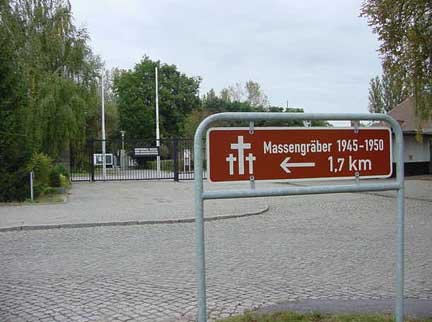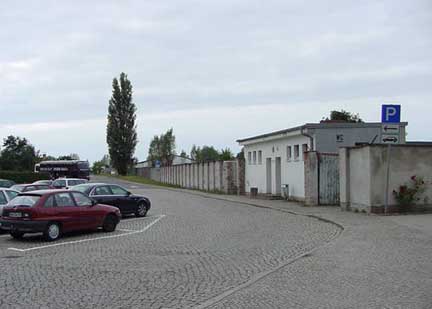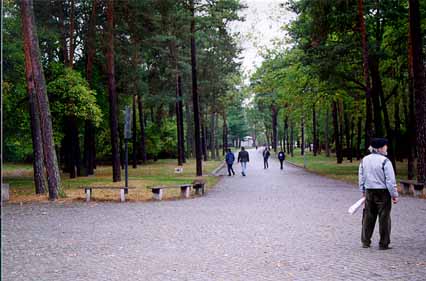Tour of Sachsenhausen Memorial Site My tour of the former Sachsenhausen concentration camp in the fall of 2002 began in Berlin where I took an S-Bahn train from the Friedrichstrasse station to the city of Oranienburg. Berlin has a vast number of train stations and you can get to Oranienburg from any of them, but you must first change to the S-Bahn at Friedrichstrasse station. After a 40-minute train ride, I reached the Oranienburg station; it was on a Sunday and there were no taxi cabs waiting, but there were street signs outside the station, which pointed in the direction of the camp. I knew from a previous visit that the camp is only about 2 kilometers from the station, so I decided to walk. The route from the train station to the Memorial Site is the same path that thousands of prisoners walked on their way to the concentration camp. You start along Stralsunder Strasse, turn right on Bernauer Strasse, left on Strasse der Einheit and then right on Strasse der Nationnen. It takes about 20 minutes to walk there, but I stopped along the way to photograph a memorial stone in honor of the prisoners who died on the Death March when Sachsenhausen was evacuated on April 21, 1945, the day before the Russian Army arrived to liberate the camp. There is also a city bus which leaves from the train station and stops at the end of the Strasse der Nationnen, where there is a parking lot in front of the entrance, but the bus was not running on Sunday. From what little I saw of Oranienburg during my walk, it seems to be a very ordinary town of 28,000 people. Some of the houses that I passed had Fall decorations: wreaths on the door, carved pumpkins on the doorstep, or paper pumpkins pasted on the front windows. Just like a town anywhere in America, I thought to myself, except that 100,000 people were killed here, according to the Russians who conducted a military tribunal in which the Commandant and 12 members of his staff confessed to mass murder. The Memorial Site, where the concentration camp used to be, is right in the town of Oranienburg. Directly to the left of the entrance gate, there is a small restaurant called Cafe Talk which serves tasty but inexpensive food. There is also a phone there if you need to call a taxi to get back to the train station, which is what I did. My taxi driver was from Sweden and did not speak English, but fortunately I knew a few words of German. The Memorial Site was open to tourists from 8:30 a.m. to 6 p.m. from April through the 15th of October 2002, and from 8:30 a.m. to 4:30 p.m. on the 16th of October 2002 through the 14th of March, 2003. The Memorial Site is closed on Mondays, as are most tourist attractions in Germany. To contact the Memorial Site, write to them at this address: Gedenkstätte und Museum Sachsenhausen, Strasse der Nationnen 22, 16515 Oranienburg Or send a fax from the USA by first dialing 011, then dial the country code for Germany which is 49, then dial the fax number which is 3301-81-09-28. From Germany, dial 03301-81-09-28 to send a fax. Just outside the Memorial Site, there is a sign, shown in the first photograph below, which points to the Mass Graves, located near the northwest exit of the former camp complex. These are not the graves of the victims of the Nazis, as you might expect; it is instead one of the three last resting places of approximately 12,000 German prisoners who died from disease, starvation and maltreatment at the hands of the Soviet occupation force which took over the Sachsenhausen concentration camp after the war and made it into Special Camp No. 7, a concentration camp where 60,000 German citizens were imprisoned without a trial. Note the three crosses which indicate that these are the graves of Christians.   Admission to the Memorial Site is free, but an Information Leaflet with a map of the grounds, which you will need, costs 25 cents in Euro money. The tourist entrance in 2002 was not the original entrance into the camp. In 1961, when the Memorial Site first opened, the former SS administration area in front of the original gate was still being used by the National People's Army of the GDR, so a new street into the camp was created, which starts at the gate at the end of the Strasse der Nationnen (Street of Nations), shown in the photograph below.  Just after you enter the tourist gate, shown in the photograph above, a sign directs you to a new Museum devoted to the history of the Nazi genocide of the Roma and Sinti, more popularly known to Americans as "Gypsies." The Museum, which is in one of the former factory buildings in the Industrial Yard just outside the prison enclosure, is described on a separate page on this web site. Midway along the path into the former concentration camp, there is a large map of the camp. Directly opposite the map is a small white building which is a tiny bookstore. There you can buy several Information Leaflets in English. On my first visit to Sachsenhausen, there were no books in English, but in 2002 there was a small section of books about the Holocaust, although nothing about Sachsenhausen in English. I did not see any official guidebook to the camp or the museums in any language. This was my second visit to the Memorial Site at the former concentration camp and I noted that the museum exhibits had been changed considerably, so any book about the exhibits would have been outdated anyway. One of the exhibits, which was formerly in the main Museum, had been removed and in 2002, it was housed in a temporary metal shed near the entrance. This is a model which shows the entire camp complex, which included a brick factory, and an industrial yard with other factories, an SS camp where the camp guards were quartered and a Prisoner of War camp in addition to the concentration camp. The camp for the prisoners was in the shape of a triangle in the center of the complex.  On the left-hand side of this path into the camp, there is a memorial stone in honor of a prisoner named August Dickman who was executed because he was a Jehovah's Witness (member of International Bible Students Association) who refused to serve in the Germany army. The memorial stone says that he was a "conscientious objector." According to Rudolf Höss, who was the adjutant in the camp at the time, there were a large number of Jehovah's Witnesses in Sachsenhausen; he wrote in his memoirs that the Jehovah's Witnesses were sent to the camps beginning in 1937, because they were "using religion to undermine the will of the people for military preparedness," by recruiting others to their beliefs about not serving in the military. Höss claimed that only those who were actively preaching against the state and recruiting others were imprisoned. When the war started, all concentration camp prisoners who were fit for military service were drafted. Höss wrote: "A large number of them (the Jehovah's Witnesses) refused to serve in the military and were, therefore, sentenced to death by Himmler as draft dodgers." Those who were willing to renounce their ideas against the military, or to serve in the army were released. In America, the Jehovah's Witnesses and the Japanese internment camp prisoners who refused to serve in the army were sent to federal prisons where they were forced to work at hard labor, but none were executed.  Nearby is another small memorial stone to the British spies who were captured and executed at Sachsenhausen. Another memorial stone, near the road, is dedicated to the prisoners who died on the Death March when the inmates were evacuated from the camp on April 21, 1945, as the Russian army was approaching. According to the memoirs of Rudolf Höss, "Reports came to Hitler that after the Americans liberated Buchenwald, prisoners were said to have armed themselves and raped and pillaged the city of Weimar. When Hitler heard this, he ordered that all the able-bodied prisoners be evacuated without exception as soon as the enemy approached the camps." Only those who were too sick or crippled to walk were left behind. After the Russians liberated the camp, 300 of the 3,000 remaining prisoners died as a result of the continuing epidemics; they are buried in a mass grave along this road. The picture below shows the street into the camp in 2002, looking back towards the entrance gate with the white bookstore in the background on the left side of the street.  Just as you get to the grounds of the former camp, there is a WC (rest room) on the right hand side. Behind it is the yellow house, partially hidden among the trees, where the camp commandant once lived. The entire camp at Sachsenhausen is completely level and wheel-chair accessible, including the restrooms. The first thing you see in front of you when you enter the grounds of the former camp is the modern building which houses the main Museum, shown in the photograph directly below. It is designed so that the entrance to the building is hidden when you view it from the camp gate house which is on the left in the picture. One of the most interesting exhibits that I saw on my first visit to the Museum in 1999 was about the counterfeit money that was printed at Sachsenhausen.  As you stand facing the Museum, to your right is Gate Number 3, the original entrance gate into the camp. Behind it is a building that is called "the Green Monster." It was used as a Casino by the SS guards in the camp. The picture below shows the gate and the green-painted house. Notice the small marker on the right side of the gate. These numbered markers correspond to the map of the Memorial Site which you can purchase at the entrance gate.  The Casino was not a gambling hall, but rather a place where the German SS soldiers ate and socialized. Continue TourSinti and Roma MuseumIndustrial YardTable of ContentsHome |